分类: WINDOWS
2011-04-25 08:54:36
YUV formats fall into two distinct groups, the where Y, U (Cb) and V (Cr) samples are packed together into macropixels which are stored in a single array, and the where each component is stored as a separate array, the final image being a fusing of the three separate planes.
In the diagrams below, the numerical suffix attached to each Y, U or V sample indicates the sampling position across the image line, so, for example, V0 indicates the leftmost V sample and Yn indicates the Y sample at the (n+1)th pixel from the left.
Subsampling intervals in the horizontal and vertical directions may merit some explanation. The horizontal subsampling interval describes how frequently across a line a sample of that component is taken while the vertical interval describes on which lines samples are taken. For example, UYVY format has a horizontal subsampling period of 2 for both the U and V components indicating that U and V samples are taken for every second pixel across a line. Their vertical subsampling period is 1 indicating that U and V samples are taken on each line of the image.
For YVU9, though, the vertical subsampling interval is 4. This indicates that U and V samples are only taken on every fourth line of the original image. Since the horizontal sampling period is also 4, a single U and a single V sample are taken for each square block of 16 image pixels.
Also, if you are interested in YCrCb to RGB conversion, you may find helpful.
People reading this page may be interested in a freeware codec from Drastic Technologies which allegedly handles the vast majority of YUV formats listed here. I've not tried it but you can find it .
| Label | FOURCC in Hex | Bits per pixel | Description |
| 0x56555941 | 32 | Combined YUV and alpha | |
| 0x524A4C43 | 8 | Cirrus Logic format with 4 pixels packed into a u_int32. A form of YUV 4:1:1 wiht less than 8 bits per Y, U and V sample. | |
| 0x76757963 | 16 | Essentially a copy of UYVY except that the sense of the height is reversed - the image is upside down with respect to the UYVY version. | |
| 0x59455247 | 8 | Apparently a duplicate of Y800 (and also, presumably, "Y8 ") | |
| IRAW | 0x57615349 | ? | Intel uncompressed YUV. I have no information on this format - can you help? |
| 0x56595549 | 16 | Interlaced version of UYVY (line order 0, 2, 4,....,1, 3, 5....) registered by Silviu Brinzei of . | |
| 0x31345949 | 12 | Interlaced version of Y41P (line order 0, 2, 4,....,1, 3, 5....) registered by Silviu Brinzei of . | |
| 0x31555949 | 12 | 12 bit format used in mode 2 of the IEEE 1394 Digital Camera 1.04 spec. This is equivalent to | |
| 0x32555949 | 24 | 24 bit format used in mode 0 of the IEEE 1394 Digital Camera 1.04 spec | |
| 0x43594448 | 16 | YUV 4:2:2 (Y sample at every pixel, U and V sampled at every second pixel horizontally on each line). A macropixel contains 2 pixels in 1 u_int32. This is a suplicate of except that the color components use the BT709 color space (as used in HD video). | |
| 0x564E5955 | 16 | A direct copy of registered by NVidia to work around problems in some old codecs which did not like hardware which offered more than 2 UYVY surfaces. | |
| UYVP | 0x50565955 | 24? | YCbCr 4:2:2 extended precision 10-bits per component in U0Y0V0Y1 order. Registered by of Evans & Sutherland. (Awaiting confirmation of component packing structure) |
| 0x59565955 | 16 | YUV 4:2:2 (Y sample at every pixel, U and V sampled at every second pixel horizontally on each line). A macropixel contains 2 pixels in 1 u_int32. | |
| 0x30313256 | 32 | 10-bit 4:2:2 YCrCb equivalent to the Quicktime format of the same name. | |
| V422 | 0x32323456 | 16 | I am told that this is an upside down version of UYVY. |
| V655 | 0x35353656 | 16? | 16 bit YUV 4:2:2 format registered by Vitec Multimedia. I have no information on the component ordering or packing. |
| VYUY | 0x59555956 | ? | ATI Packed YUV Data (format unknown but you can get hold of a codec supporting it ) |
| 0x32323459 | 16 | Direct copy of UYVY as used by ADS Technologies Pyro WebCam firewire camera. | |
| 0x32595559 | 16 | YUV 4:2:2 as for UYVY but with different component ordering within the u_int32 macropixel. | |
| 0x56595559 | 16 | Duplicate of YUY2 | |
| 0x564E5559 | 16 | A direct copy of registered by NVidia to work around problems in some old codecs which did not like hardware which offered more than 2 YUY2 surfaces. | |
| 0x55595659 | 16 | YUV 4:2:2 as for UYVY but with different component ordering within the u_int32 macropixel. | |
| 0x50313459 | 12 | YUV 4:1:1 (Y sample at every pixel, U and V sampled at every fourth pixel horizontally on each line). A macropixel contains 8 pixels in 3 u_int32s. | |
| 0x31313459 | 12 | YUV 4:1:1 with a packed, 6 byte/4 pixel macroblock structure. | |
| 0x31313259 | 8 | Packed YUV format with Y sampled at every second pixel across each line and U and V sampled at every fourth pixel. | |
| 0x54313459 | 12 | Format as for Y41P but the lsb of each Y component is used to signal pixel transparency . | |
| 0x54323459 | 16 | Format as for UYVY but the lsb of each Y component is used to signal pixel transparency . | |
| 0x50565559 | 24? | YCbCr 4:2:2 extended precision 10-bits per component in Y0U0Y1V0 order. Registered by of Evans & Sutherland. | |
| 0x30303859 | 8 | Simple, single Y plane for monochrome images. | |
| 0x20203859 | 8 | Duplicate of Y800 as far as I can see. | |
| 0x20363159 | 16 | 16-bit uncompressed greyscale image. |
This is a 4:4:4 YUV format with 8 bit samples for each component along with an 8 bit alpha blend value per pixel. Component ordering is A Y U V (as the name suggests).
UYVY is probably the most popular of the various YUV 4:2:2 formats. It is output as the format of choice by the Radius Cinepak codec and is often the second choice of software MPEG codecs after YV12.
Y422 and UYNV appear to be direct equivalents to the original UYVY.
HDYC is equivalent in layout but pixels are described using the BT709 color space as used in HD video systems rather than the BT470 SD video color space typically used. Apparently there is a description in the DeckLink DirectShow SDK documentation at , find DeckLink SDK 5.6.2 for Windows XP and download , set product to None, serial no is not required), see "Video Formats" section.
| Horizontal | Vertical | |
| Y Sample Period | 1 | 1 |
| V Sample Period | 2 | 1 |
| U Sample Period | 2 | 1 |
Effective bits per pixel : 16
Positive biHeight implies top-down imge (top line first)

IUYV is basically the same as UYVY with the exception that the data is interlaced. Lines are ordered 0,2,4,....,1,3,5.... instead of 0,1,2,3,4,5,....
This FOURCC, allegedly registered by Creative Labs, is essentially a duplicate of UYVY. The only difference is that the image is flipped vertically, the first u_int16 in the buffer representing the bottom line of the viewed image. Note that the FOURCC is comprised of lower case characters (so much for the upper case convention !)
| Horizontal | Vertical | |
| Y Sample Period | 1 | 1 |
| V Sample Period | 2 | 1 |
| U Sample Period | 2 | 1 |
Effective bits per pixel : 16
Positive biHeight implies bottom-up image (botton line first)

YUY2 is another in the family of YUV 4:2:2 formats and appears to be used by all the same codecs as UYVY.
| Horizontal | Vertical | |
| Y Sample Period | 1 | 1 |
| V Sample Period | 2 | 1 |
| U Sample Period | 2 | 1 |
Effective bits per pixel : 16
Positive biHeight implies top-down image (top line first)

There is a which contains information on playing AVIs which include video stored in YUY2 format.
Despite being a simple byte ordering change from YUY2 or UYVY, YVYU seems to be seen somewhat less often than the other two formats defined above.
| Horizontal | Vertical | |
| Y Sample Period | 1 | 1 |
| V Sample Period | 2 | 1 |
| U Sample Period | 2 | 1 |
Effective bits per pixel : 16
Positive biHeight implies top-down image (top line first)

This YUV 4:1:1 format is registered as a PCI standard format. Mediamatics MPEG 1 engine is the only codec (other than a Brooktree internal one) that I know of that can generate it.
| Horizontal | Vertical | |
| Y Sample Period | 1 | 1 |
| V Sample Period | 4 | 1 |
| U Sample Period | 4 | 1 |
Effective bits per pixel : 12
Positive biHeight implies top-down image (top line first)

I was originally told that this was a duplicate of however it seems that this is not the case after all. Y411 is a packed YUV 4:1:1 format with a 6 pixel macroblock structure containing 4 pixels. Component packing order is:
U2 Y0 Y1 V2 Y2 Y3
I have not been able to find 100% confirmation of the position for the U and V samples. I suspect that the chroma samples are probably both taken at the position of Y2 but this is a guess just now.
I have recently been informed that this format is identical to.
| Horizontal | Vertical | |
| Y Sample Period | 1 | 1 |
| V Sample Period | 4 | 1 |
| U Sample Period | 4 | 1 |
Effective bits per pixel : 12
Positive biHeight implies top-down image (top line first)
IY41 is basically the same as Y41P with the exception that the data is interlaced. Lines are ordered 0,2,4,....,1,3,5.... instead of 0,1,2,3,4,5,....
I have yet to find anything that will output Y211 ! The format looks very much like the missing YUV 4:2:2 ordering but Y samples are only taken on every second pixel. Think of it as a half width 4:2:2 image and double the width on display.
| Horizontal | Vertical | |
| Y Sample Period | 2 | 1 |
| V Sample Period | 4 | 1 |
| U Sample Period | 4 | 1 |
Effective bits per pixel : 8
Positive biHeight implies top-down image (top line first)

This format is identical to except for the fact that the least significant bit of each Y component forms a chromakey channel. If this bit is set, the YUV image pixel is displayed, if cleared, the pixel is transparent (and the underlying graphics pixel is shown).
Positive biHeight implies top-down image (top line first)
This format is identical to except for the fact that the least significant bit of each Y component forms a chromakey channel. If this bit is set, the YUV image pixel is displayed, if cleared, the pixel is transparent (and the underlying graphics pixel is shown).
Positive biHeight implies top-down image (top line first)
Cirrus Logic's format packs 4 pixel samples into a single u_int32 by sacrificing precision on each sample. Y samples are truncated to 5 bits each, U and V have 6 bits per sample.
| Horizontal | Vertical | |
| Y Sample Period | 1 | 1 |
| V Sample Period | 4 | 1 |
| U Sample Period | 4 | 1 |
Effective bits per pixel : 8
Positive biHeight implies top-down image (top line first)

The IYU1 format is a 12 bit format used in mode 2 of the IEEE 1394 Digital Camera 1.04 spec ("1394-based Digital Camera Specification, Version 1.04, August 9, 1996", page 14.). The format, a duplicate of , is YUV (4:1:1) according to the following pattern:
| Byte | 0 | 1 | 2 | 3 | 4 | 5 |
| Sample | U(K+0) | Y(K+0) | Y(K+1) | V(K+0) | Y(K+2) | Y(K+3) |
| Horizontal | Vertical | |
| Y Sample Period | 1 | 1 |
| V Sample Period | 4 | 1 |
| U Sample Period | 4 | 1 |
The IYU2 format is a 24 bit format used in mode 0 of the IEEE 1394 Digital Camera 1.04 spec (ibid.) The format is YUV (4:4:4) according to the following pattern:
| Byte | 0 | 1 | 2 | 3 | 4 | 5 |
| Sample | U(K+0) | Y(K+0) | V(K+0) | U(K+1) | Y(K+1) | V(K+1) |
| Horizontal | Vertical | |
| Y Sample Period | 1 | 1 |
| V Sample Period | 1 | 1 |
| U Sample Period | 1 | 1 |
This is another format similar to YUY2 and it's aliases. The difference here is that each Y, U and V samples is 10 bits rather than 8. I am still waiting to hear how the samples are packed - is a macropixel just 5 bytes long with all the samples packed together or is there more to it than this?
have implemented this Quicktime format for Windows. It is a 10 bit per component, YCrCb 4:2:2 format in which samples for 5 pixels are packed into 4 4-byte little endian words. Rather than repeat the details here, I suggest looking at the original definition on the Quicktime web site.
Supposedly there are images described as "YUV10" that are formatted similarly to this aside from the bit ordering (the correspondent mentioned having to run ntoh on the pixel data to reformat from YUV10 to V210. Despite 20 years of C, I've not heard of ntoh but I suspect it performs big-endian to little-endian conversion).
| Label | FOURCC in Hex | Bits per pixel | Description |
| 0x39555659 | 9 | 8 bit Y plane followed by 8 bit 4x4 subsampled V and U planes. Registered by Intel. | |
| 0x39565559 | 9? | Registered by Intel., this is the format used internally by Indeo video code | |
| 0x39304649 | 9.5 | As YVU9 but an additional 4x4 subsampled plane is appended containing delta information relative to the last frame. (Bpp is reported as 9) | |
| 0x36315659 | 16 | 8 bit Y plane followed by 8 bit 2x1 subsampled V and U planes. | |
| 0x32315659 | 12 | 8 bit Y plane followed by 8 bit 2x2 subsampled V and U planes. | |
| 0x30323449 | 12 | 8 bit Y plane followed by 8 bit 2x2 subsampled U and V planes. | |
| 0x56555949 | 12 | Duplicate FOURCC, identical to I420. | |
| 0x3231564E | 12 | 8-bit Y plane followed by an interleaved U/V plane with 2x2 subsampling | |
| 0x3132564E | 12 | As NV12 with U and V reversed in the interleaved plane | |
| 0x31434D49 | 12 | As YV12 except the U and V planes each have the same stride as the Y plane | |
| 0x32434D49 | 12 | Similar to IMC1 except that the U and V lines are interleaved at half stride boundaries | |
| 0x33434D49 | 12 | As IMC1 except that U and V are swapped | |
| 0x34434D49 | 12 | As IMC2 except that U and V are swapped | |
| 0x4C504C43 | 12 | Format similar to YV12 but including a level of indirection. | |
| Y41B | 0x42313459 | 12? | Weitek format listed as "YUV 4:1:1 planar". I have no other information on this format. |
| Y42B | 0x42323459 | 16? | Weitek format listed as "YUV 4:2:2 planar". I have no other information on this format. |
| 0x30303859 | 8 | Simple, single Y plane for monochrome images. | |
| 0x20203859 | 8 | Duplicate of Y800 as far as I can see. | |
| 0x31595843 | 12 | Awaiting clarification of format. | |
| 0x32595842 | 16 | Awaiting clarification of format. |
This format dates back to the days of the ActionMedia II adapter and comprises an NxN plane of Y samples, 8 bits each, followed by (N/4)x(N/4) V and U planes.
| Horizontal | Vertical | |
| Y Sample Period | 1 | 1 |
| V Sample Period | 4 | 4 |
| U Sample Period | 4 | 4 |
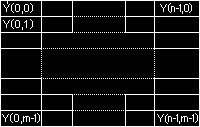
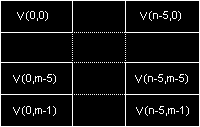
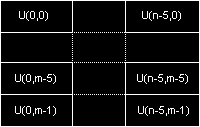
Positive biHeight implies top-down image (top line first)
ATI has a codec supporting this format that you can download from .
states that YUV9 is "the color encoding scheme used in Indeo video technology. The YUV9 format stores information in 4x4 pixel blocks. Sixteen bytes of luminance are stored for every 1 byte of chrominance. For example, a 640x480 image will have 307,200 bytes of luminance and 19,200 bytes of chrominance." This sounds exactly the same as to me. Anyone know if there is any difference?
A derivative of YVU9, IF09 contains the basic 3 planes for Y, V and U followed by an additional (N/4)x(N/4) plane of "skip blocks". This final plane forms a basic delta encoding scheme which can be used by a displayer to decide which pixels in the image are unchanged from the previous displayed frame. The strange number of bits per pixel listed for the format results from the fact that an NxN image is described using N2+3(N/4)2 bytes.
This format is generated by Intel's Indeo codecs though users should beware - the original 32 bit Indeo 3.2 shipped with Windows 95 and the beta levels of Indeo 4.1 contain bugs which cause them to generate protection faults when using IF09. Fixed versions of these codecs are available from Intel.
| Horizontal | Vertical | |
| Y Sample Period | 1 | 1 |
| V Sample Period | 4 | 4 |
| U Sample Period | 4 | 4 |



Positive biHeight implies top-down image (top line first)
To be completed...
This is the format of choice for many software MPEG codecs. It comprises an NxM Y plane followed by (N/2)x(M/2) V and U planes.
| Horizontal | Vertical | |
| Y Sample Period | 1 | 1 |
| V Sample Period | 2 | 2 |
| U Sample Period | 2 | 2 |

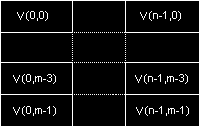
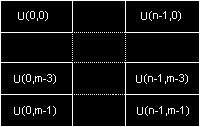
Positive biHeight implies top-down image (top line first)
ATI says they have but I can't find it on their site. If you would like something similar for Quicktime, .
This format is basically a version of with higher chroma resolution. It comprises an NxM Y plane followed by (N/2)xM U and V planes.
| Horizontal | Vertical | |
| Y Sample Period | 1 | 1 |
| V Sample Period | 2 | 1 |
| U Sample Period | 2 | 1 |
These formats are identical to YV12 except that the U and V plane order is reversed. They comprise an NxN Y plane followed by (N/2)x(N/2) U and V planes. Full marks to Intel for registering the same format twice and full marks to Microsoft for not picking up on this and rejecting the second registration.
(Note: There is some confusion over these formats thanks to the definitions on which tend to suggest that the two FOURCCs are different. One is described as a 4:2:0 format while the other is described as 4:1:1. Later, however, the same page states that YV12 is the same as both of these with the U and V plane order reversed. I would consider 4:2:0 to imply 1 chroma sample for every 2x2 luma block and 4:1:1 to imply 1 chroma sample for every 4x1 luma block but it seems as if the Microsoft writer may have been using the terms interchangeably. If you know these formats, please could you whether the definition here is correct or whether I need to update one or other?)
| Horizontal | Vertical | |
| Y Sample Period | 1 | 1 |
| V Sample Period | 2 | 2 |
| U Sample Period | 2 | 2 |



Positive biHeight implies top-down image (top line first)
This format introduces an extra level of indirection in the process of accessing YUV pixels in the surface. Locking the DirectDraw or DCI CLPL surface returns a pointer which itself points to three other pointers. These pointers respectively point to an NxN Y plane, an (N/2)x(N/2) U plane and an (N/2)x(N/2) V plane. The Y plane pointer retrieved is (allegedly) valid even when the surface is subsequently unlocked but the U and V pointers can only be used with a lock held (as you should be doing anyway if adhereing to the DirectDraw/DCI spec).
| Horizontal | Vertical | |
| Y Sample Period | 1 | 1 |
| V Sample Period | 2 | 2 |
| U Sample Period | 2 | 2 |



Positive biHeight implies top-down image (top line first)
This format contains only a single, 8 bit Y plane for monochrome images. Apparent duplicate FOURCCs are "Y8" and "GREY".
| Horizontal | Vertical | |
| Y Sample Period | 1 | 1 |
| V Sample Period | N/A | N/A |
| U Sample Period | N/A | N/A |

This format contains only a single, 16 bit Y plane for monochrome images. Each pixel is represented by a 16 bit, little endian luminance sample.
| Horizontal | Vertical | |
| Y Sample Period | 1 | 1 |
| V Sample Period | N/A | N/A |
| U Sample Period | N/A | N/A |

YUV 4:2:0 image with a plane of 8 bit Y samples followed by an interleaved U/V plane containing 8 bit 2x2 subsampled colour difference samples.
| Horizontal | Vertical | |
| Y Sample Period | 1 | 1 |
| V (Cr) Sample Period | 2 | 2 |
| U (Cb) Sample Period | 2 | 2 |
Microsoft defines this format as follows:
"A format in which all Y samples are found first in memory as an array of unsigned char with an even number of lines (possibly with a larger stride for memory alignment), followed immediately by an array of unsigned char containing interleaved Cb and Cr samples (such that if addressed as a little-endian WORD type, Cb would be in the LSBs and Cr would be in the MSBs) with the same total stride as the Y samples. This is the preferred 4:2:0 pixel format."
YUV 4:2:0 image with a plane of 8 bit Y samples followed by an interleaved V/U plane containing 8 bit 2x2 subsampled chroma samples. The same as except the interleave order of U and V is reversed.
| Horizontal | Vertical | |
| Y Sample Period | 1 | 1 |
| V (Cr) Sample Period | 2 | 2 |
| U (Cb) Sample Period | 2 | 2 |
Microsoft defines this format as follows:
"The same as , except that Cb and Cr samples are swapped so that the chroma array of unsigned char would have Cr followed by Cb for each sample (such that if addressed as a little-endian WORD type, Cr would be in the LSBs and Cb would be in the MSBs)."
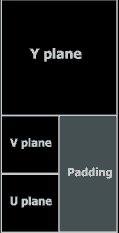 Similar to ,
this format comprises an NxN Y plane followed by (N/2)x(N/2) U and V
planes. The U and V planes have the same stride as the Y plane and are
restricted to start on 16 line boundaries.
Similar to ,
this format comprises an NxN Y plane followed by (N/2)x(N/2) U and V
planes. The U and V planes have the same stride as the Y plane and are
restricted to start on 16 line boundaries.
| Horizontal | Vertical | |
| Y Sample Period | 1 | 1 |
| V (Cr) Sample Period | 2 | 2 |
| U (Cb) Sample Period | 2 | 2 |
Microsoft defines this format as follows:
"The same as , except that the stride of the Cb and Cr planes is the same as the stride in the Y plane. The Cb and Cr planes are also restricted to fall on memory boundaries that are a multiple of 16 lines (a restriction that has no effect on usage for the standard formats, since the standards all use 16×16 macroblocks)."
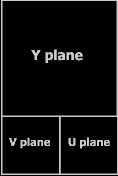 Similar to ,
this format comprises an NxN Y plane followed by "rectangularly
adjacent" (N/2)x(N/2) U and V planes. Lines of U and V pixels are
interleaved at half stride boundaries below the Y plane.
Similar to ,
this format comprises an NxN Y plane followed by "rectangularly
adjacent" (N/2)x(N/2) U and V planes. Lines of U and V pixels are
interleaved at half stride boundaries below the Y plane.
| Horizontal | Vertical | |
| Y Sample Period | 1 | 1 |
| V (Cr) Sample Period | 2 | 2 |
| U (Cb) Sample Period | 2 | 2 |
Microsoft defines this format as follows:
"The same as , except that Cb and Cr lines are interleaved at half-stride boundaries. In other words, each full-stride line in the chrominance area starts with a line of Cr, followed by a line of Cb that starts at the next half-stride boundary. (This is a more address-space-efficient format than , cutting the chrominance address space in half, and thus cutting the total address space by 25%.) This runs a close second in preference relative to , but appears to be more popular."
The same as except for swapping the U and V order.
The same as except for swapping the U and V order.
Planar YUV 4:1:1 format registered by Conexant. Awaiting clarification of pixel component ordering.
Planar YUV 4:2:2 format registered by Conexant. Awaiting clarification of pixel component ordering.
原文地址